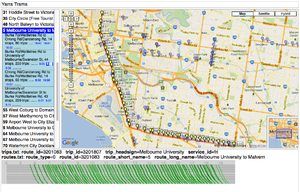WP Essentials
This is a Work Package as part of the OSSTIP project.
Inputs: Publically-available GIS data of transport networks and related shapes, sample GTFS files, some samples of modified network GIS files. Outputs: Short evaluation report on each tool, stating pros and cons, saved example code and datasets in project repository/dropbox.
Estimated Time: Small-medium
Requirements Summary
The goal during this WP would be to simultaneously assemble and better understand the key data currently available for Melbourne’s transport network, compared to requirements of the GIS-T tools of interest (being evaluated in WP2 (p5)), and initial plans for how to bridge the available needs.
Key formats and data sources are likely to comprise:
- GIS vector Shapefiles of public transport networks and routes (and how to best organise them);
- Timetables, likely in the form of the GTFS (General Transit Feed Specification)1;
- Street networks, like OpenStreetMap, that will support including walking (and possibly cycling) into the journey planner module;
- Supplementary data that might support later stages of the project: e.g. capacity and loading of current transport networks, VISTA travel activity data, etc.
Best sources for the data should be documented :- and if a good public source doesn’t yet exist, then ways of generating the required data from intermediate forms should be recorded.
The WP would include assembling as complete as possible a GTFS timetable for Melbourne as it currently stands based on available data, and at the same time documenting and sharing expertise within the team of how to effectively work with the format. It could also include experimenting with tools to extract useful information from GTFS files, such as route maps, and current average speeds and frequencies. This kind of initial experimentation would form the basis for OSSTIP/WP5s workflow for converting between the tools.
With the kind of optimal workflow for converting between the formats as specified in OSSTIP/WP5 in mind, at this stage we should also start preliminary work on how to add/attach required ‘metadata’ to the routes that will support their conversion into a full timetable – such as desired frequency, and average speed.
Results
Relevant Project blog entries:
OpenStreetMap Data
Procuring [[OpenStreetMap data for Melbourne proved relatively straightforward] - though it does need a fairly high-speed internet connection and quota, as even zipped up, these files run into the 50MB_+ range. This is only to be expected when downloading a street network for an entire city!
The most helpful source I found for getting OSM data for the Melbourne Metro region to support trip planning calculations was from the excellent "Metro Extracts" website:- http://metro.teczno.com/#melbourne
This website updates the OSM data monthly from the latest global records, so is a good source.
Other possibilities that gave helpful info, and could be useful in future:
- http://wiki.openstreetmap.org/wiki/Downloading_data#Choose_your_region has useful tips, including how to use web service APIs to ask for sub-sections of large datasets, but I didn't need to use this in the end.
- http://download.bbbike.org/osm/bbbike/Melbourne/ - OSM Extracts for Melbourne, from a variety of providers, with a cycling focus.
GTFS Data Availability
GTFS schedules are the data format preferred by many Open Source tools.
(TODO.)
Tools for initial testing and evaluation of GTFS data

The friend who helped me set up GTFS data for Melbourne also recommended the useful Google Transit Data Feed library. In addition to a range of scripts and libraries for transforming and checking the data, Transit Feed includes a very helpful small web-application, ScheduleViewer, that can allow interactive viewing and checking of GTFS datasets for a region. See image at right.